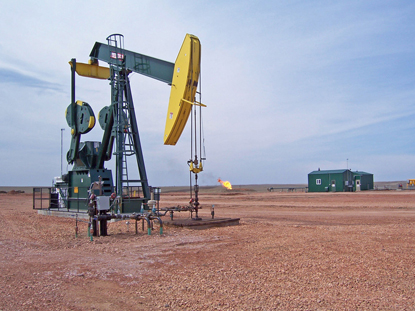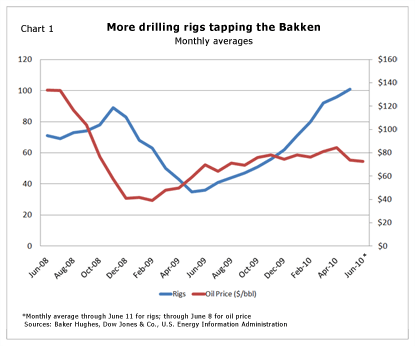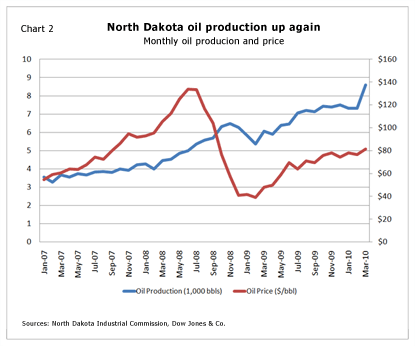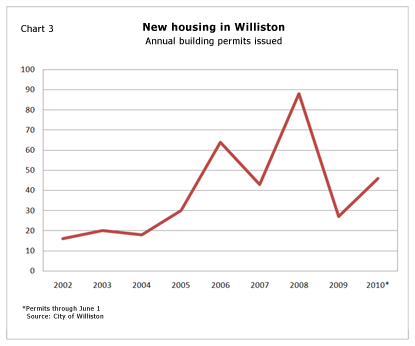
Ward Koeser, mayor of Williston, N.D., has a problem that many community leaders in the Ninth District would love to have in these uncertain times: not enough housing for all the workers flocking to town to take jobs in the oil industry. Workers earning solid paychecks are doubling up in high-priced apartments and motel rooms, living in company-owned trailers or, as a last resort, sleeping in their trucks.
“We’re having good luck getting workers here,” Koeser said. “They’re coming from all over the country, because the economy is very, very strong right now. The problem we have is [not enough] housing.”
Tight living space is just one indication in Williston, the hub of North Dakota’s oil industry, that the state’s oil boom is back on track. Other signs of revival include roads thick with trucks headed out to the oil fields and numerous help-wanted signs downtown.
Over the past year, oil drilling and production in northwestern North Dakota have rebounded from a slowdown after the financial crisis in the fall of 2008, when oil prices plummeted and oil field investment withered (see the September 2009 fedgazette). In fact, current levels of drilling and pumping in the Bakken Formation—a deep layer of oil-bearing shale that stretches into northeastern Montana and Canada—are higher than two years ago, when oil prices peaked at over $130 per barrel. In early June, a record number of rigs were drilling for Bakken crude, and wells were producing a record amount of oil, making North Dakota the fourth-largest oil-producing state in the country.
The main driver behind the surge in activity is a year-long rise in the price of crude oil, but increased shipping capacity and new drilling techniques have also played a role in shifting the industry back into high gear.
Renewed investment in the Bakken by oil companies has restored hundreds of well-paying jobs in oil fields, increased local government tax receipts and boosted revenues for motels, restaurants and other non-oil businesses—although many are having trouble competing with oil companies for labor. As for demand for housing, developers are responding, erecting scores of new homes and apartment units in Williston and other oil communities.
A recent drop in oil prices worries some people in the district’s oil patch; they remember the oil bust of the 1980s, when oil activity dried up and the region’s economy tanked. But for now, the industry’s vital signs—and therefore the economic prospects for the region—are strong.
Drill, baby, drill
The fortunes of the Bakken closely track the price of crude, and both reached their nadir early last year. By May 2009, only 35 rotary rigs were drilling in North Dakota, less than half the number that were operating the previous fall. Oil production tapered off too; with a barrel of oil trading for less than $60, it made no sense to operate wells at full capacity. Hundreds of oil workers lost their jobs, leading to a slowdown in housing construction and lower revenues for non-oil businesses.
Crude prices began climbing last summer as the economy stabilized. Higher oil revenues, combined with the thawing of capital markets, prompted a fresh wave of investment in the Bakken by oil companies such as Hess Corp. and EOG Resources. Spending on oil exploration, drilling and well development has accelerated over the past year, said Ron Ness, president of the North Dakota Petroleum Council, an oil and gas trade association. “We are continuing to see a surge in oil production,” he said. “We’re attracting massive amounts of capital … just in drilling costs alone.”
Based on the number of active drilling rigs in the state, Ness estimates that oil companies currently have about $700 million invested in tapping new oil supplies in the Bakken. Drilling and completing a typical Bakken well—an operation that involves tapping and fracturing a shallow layer of shale nearly two miles below the surface—costs about $6 million.
Measured by drilling activity, and the output of finished wells, North Dakota’s oil fields have never been busier and more prolific. As of mid June, 113 rigs were drilling in the state, according to Baker Hughes, an oil field technology firm that tracks drilling activity (see Chart 1). That’s more than three times the number of rigs active a year ago. Oil production in the state dipped early last year but has since rebounded strongly, according to state figures (see Chart 2). In March, output surged to 8.6 million barrels, the most oil produced in the state since drilling began in 1951.
(Across the border in Montana, oil drilling has also picked up over the past year, but monthly oil production in the state has continued to fall from its apex in 2006. North Dakota now accounts for most oil activity in the district.)
For years, transportation constraints have limited the amount of oil North Dakota producers could ship to market. Shipping capacity increased this year, relieving the bottleneck and helping to drive up production.
In January, Enbridge Inc. of Canada completed a pipeline expansion that increased the amount of Bakken oil piped to refineries in Minnesota and beyond by 50 percent, to about 162,000 barrels a day. In the same month, Texas-based EOG Resources starting shipping 60,000 barrels of crude daily from its new rail terminal near Stanley, N.D.
Oil brokers mark down North Dakota crude about 10 percent below oil from other areas of the United States because of transportation costs. Industry officials expect the pipeline and rail expansions to reduce this discount over time, making Bakken oil more competitive and encouraging more drilling and production.
Impetus for increased oil activity has also come from technological advances that make drilling more worthwhile for oil companies and investors. Fracturing—injecting a mixture of water and sand into the wellbore—is necessary to break up the shale and bring crude to the surface. Over the past 18 months, a number of Bakken oil firms have developed a method of fracturing the wellbore multiple times to coax more oil from wells, even those in historically less-productive areas. “It’s making wells economic that weren’t economic before,” Ness said.
Riding the wave
The jump in oil activity has been a shot of espresso for more than 200 oil field service firms in the region that provide oil and drilling companies with everything from land leasing services to drilling fluids to well components. A year and a half ago, many of these firms had laid off employees and were scratching for any type of work. Today they’re expanding, intent on riding the wave of oil investment.
They’re hiring: Early in 2009, oil-related companies listed only 45 job orders statewide with Job Service North Dakota; in the second week of June, over 250 job listings were posted.
And they’re borrowing to upgrade facilities and buy new equipment. “With the boom that’s going on in the oil and gas industry, we’re getting a lot more [demand for loans],” said Frank Keogh, president of American State Bank and Trust Co. in Williston. Some borrowers are startups and out-of-state companies that have recently established operations in the area.
Oil’s resurgence also has meant additional revenue for local non-oil firms—retailers, restaurants and other Main Street businesses that serve oil workers and their families. But these firms don’t seem to be expanding as much as oil-related companies; Keogh hasn’t seen an increase in borrowing by non-oil firms. Many business owners who weathered the 1980s downturn remain cautious about spending money to attract customers who may leave town after a few years.
“The confidence is beginning to spill over into local businesses, but they are still wary of an extended bust occurring,” said Lynn Helms, director of the state Department of Mineral Resources, via e-mail.
A downside of the boom for non-oil businesses is the labor drain that runs from their doors straight to the oil fields. In a reprise of 2008, local restaurants, grocery stores and other firms are struggling to hire and retain employees. In late May, Job Service of North Dakota reported over 400 job openings at non-oil firms in the Williston area, few paying as well as entry-level positions on drilling crews or at oil field service firms. (Last fall, the average annual wage in the oil industry in Williams County was $82,000, about 60 percent higher than the average for all occupations.)
“The service and retail sectors of employment are taking the hardest hit,” said Shawn Wenko, workforce development coordinator for the city of Williston, in an e-mail. “It is impossible for them to compete with these wages.”
Somewhere to lay your hard hat
Another consequence of a thriving oil industry is a dearth of permanent housing—the issue that concerns Koeser. Since the 1980s, developers and lenders have been reluctant to invest in housing in northwestern North Dakota, for fear of defaults on the downswing of a cyclical oil economy. Banks in the state have been especially leery of financing apartment projects—just the sort of flexible living space sought by oil workers and their families.
The influx of oil workers this spring has overwhelmed the housing supply, creating a space crunch and driving up rents. Many oil workers live in motel rooms booked for them by their employers, or temporary “man camps” erected on drilling sites. However, both private developers and local government have taken steps to provide more housing.
In Williston, local banks remain cautious lenders for housing construction. But out-of-state developers are putting up single- and multifamily homes at a rapid pace. In 2009, 27 new homes were built in the city, a sharp drop from previous years, according to permit figures (see Chart 3). Through June 1 of this year, 46 new homes had been built or approved. In addition, six apartment buildings had been permitted—two more than in all of last year.
City officials hope to foster more development by securing state backing for bond financing of new infrastructure on raw land. The city is working with the state to develop a pilot program in which the Bank of North Dakota would guarantee half the value of $10 million in municipal bonds issued by the city to pay for improvements such as roads, sidewalks and streetlights.
In the 1980s oil bust, the city got burned on bonds it had issued for housing infrastructure that went unused. Koeser sees the program, which may serve as a model for future legislation extending aid to other North Dakota communities, as a way to spread the risks of building housing in an oil town. “We’re trying to be careful that we don’t overdrive our headlights, that we limit the amount of risk that we take,” he said.
New housing, including three apartment buildings, is also going up in Stanley, a town of 1,500 that over the past four years has become an operating base for oil companies drawn to the enormously productive oil fields of Mountrail County.
In it for the long haul?
In early June, crude oil prices were hovering in the low $70s per barrel, a considerable drop from where they stood in March. But so far, the price dip, partly due to investor anxiety about the slow pace of economic recovery, hasn’t appeared to dim optimism in North Dakota.
Several sources said there’s a growing conviction in the oil fields and on Main Street that a bust isn’t in the cards—the boom will continue with only minor hiccups now that the oil industry has awakened from last year’s swoon.
Helms says that current levels of drilling and pumping in the Bakken could be sustained even if prices fall to $50 a barrel, because of increased well productivity and expected reductions in the market discount on North Dakota oil.
Ness of the Petroleum Council isn’t so sure. “If prices continue to fall, you would see some slowing” of activity, he said, as the stock values of oil companies fall and drillers pull back into the most productive areas of the Bakken.
But he’s encouraged by record attendance at last month’s state petroleum conference in Bismarck and by a recent upbeat state report on the Three Forks formation, a second layer of oil-rich shale underlying the Bakken. The Department of Mineral Resources estimates that Three Forks holds up to 2 billion barrels of oil recoverable with today’s technology. Together with the Bakken’s known reserves, that’s enough oil to keep North Dakota wells pumping for 30 years or more at today’s production rates.
An oil play of that magnitude is likely to attract increased investment in coming years, driven partly by the BP oil spill, which has cast a pall over deepwater drilling in the Gulf of Mexico. Industry analysts expect anticipated tighter federal regulation of offshore rigs to spur oil exploration and drilling on land.
Residents of the oil patch are constantly aware that the worm can turn quickly, as it did in the early 1980s and after the 2008 banking crisis. Said Keogh of American State Bank: “There’s no question that is on everybody’s mind as they consider making a long-term investment into a new business, or resetting an existing one. But over time, as this level of activity sustains itself or even grows, I see some of that concern melting away. People are starting to embrace this as a longer-term project.”








